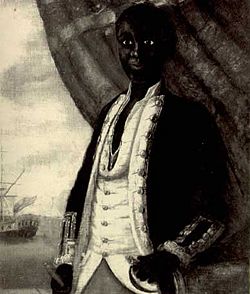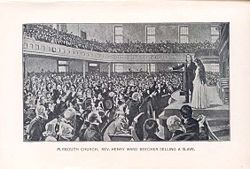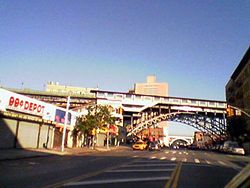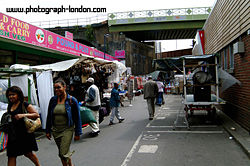| wiki | search |
Main Page | Groups and Assignments | Bios | History | Harlem | Diversity Today | Help
Development of Black Communities in New York and in London
The presence of black populations in both the cities of New York and London can be attributed to the European Age of Imperialism, when countries such as Britain began to expand political, social, and economic control beyond their own borders. Not only were black populations uprooted from Africa to the New World as part of the slave trade, but many were also made to work as interpreters, sailors and soldiers for the colonizing powers. The differences in the ways in which the black populations were employed by Britain and by North America fostered the growth of different black communities and cultures as blacks were incorporated into these different places. Blacks in New York under the rule of the British were almost exclusively slaves and were forced to work in secret to establish some sort of popular culture and to develop a black community. They formed a more coherent type of popular culture and ethnic identity with the gradual emancipation laws that freed them from bondage, and they created a vibrant culture with music, dance, theater, among other things that they had previously had to hide.
The formation of the black community in London had its differences, though it too, was centered on the slave trade. When many affluent plantation owners and slave traders returned home to London, they brought with them their personal slaves, who became a sort of fashion accessory for the wealthy Londoners. Combined with the large numbers of blacks who arrived in London as sailors or soldiers for Britain and the black Loyalists from the United States who fled following the Revolutionary War, this group formed London’s first black communities. An important fact about blacks in London that shaped the black community is that for quite some time their status was ambiguous. “Free” blacks were employed in domestic service and other lowly jobs and could, theoretically, work for a place in society. The slaves brought to London, however, were in a difficult situation, as law neither recognized the legality of slavery nor condemned it. As a result, servants were subject to their employer’s will. Similarly, soldiers, sailors, and Loyalists held a difficult position as they were not allowed to take part in the city’s poor relief system, could not be returned to their home countries, and had difficulty finding sufficient employment, all of which resulted in a large community of beggars.
Current Trends in the Black Populations of New York and London
Over time, in periods of immigration and migration, growth and decline, prosperity and desperation, the black community has developed in New York and become over a quarter of the city’s total population at over 2 million people as of 2000, but always marked by a disadvantage that continues to haunt the community. Opportunities improved for blacks in London over the years in times of labor shortages and with political support. Similarly the cultural trend of interracial marriage (due to an inequality in the number of black males v. black females) has played a big role in the communities created in London. In London, the rate of interracial marriages is 10 times higher than the rest of Europe and, according to some sources, the highest in the world.
According to the 2001 census, 380,000 residents of London identified themselves as Black or Black British out of a population of almost 7.2 million. The makeup of the communities are different as well: While both London and NY have large West Indian/Afro-Caribbean populations (over 520,000 New Yorkers and 350,000 Londoners as of 2000), London has a larger Black African population (485,000 people as opposed to around 130,000 in New York City) because of Britain's colonization of Africa and the British Nationality Act of 1948, which granted citizenship to British subjects and which caused Africans to enter the country in large numbers. Differences in these communities also stem from other factors, including expectations of black immigrants to these two cities and the makeup of existing populations in New York and London.
While blacks, specifically West Indians, immigrating to New York City expect to encounter racial discrimination and difficulty associated with their color in the United States, those who immigrate to London, known as Afro-Caribbeans, may have a different idea about what they will encounter. While they do not experience the housing or residential segregation black immigrants to New York City find upon arrival, the common Afro-Carribean idea of Britain as the "motherland" that these people hold is quickly shot down in London. Brought up to believe they are a part of Britain's legacy and with traditions rooted in British culture, Afro-Caribbeans quickly find that they are strangers in London.
The existing black populations in New York City and London have a large effect on the reception and experiences of immigrant blacks to these cities. In NYC, black immigrants find that they must find a place among the African-American population. They face a difficult situation because of the discrimination against African-Americans in NY and in the United States. While black immigrants often try to distance themselves from the existing black population, they often find it difficult to do so, and end up straddling the line between joining African-Americans and resenting them. In London, "black" is almost immediately thought to mean Afro-Caribbean, and so the experience of these immigrants is quite different and somewhat less complicated in this regard.




